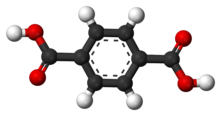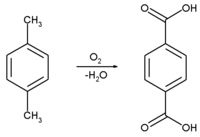This is an old revision of this page, as edited by Beetstra (talk | contribs) at 14:28, 10 December 2010 (Script assisted update of identifiers from ChemSpider, CommonChemistry and FDA for the Chem/Drugbox validation project - Updated: InChI1->InChI StdInChI StdInChIKey.). The present address (URL) is a permanent link to this revision, which may differ significantly from the current revision.
Revision as of 14:28, 10 December 2010 by Beetstra (talk | contribs) (Script assisted update of identifiers from ChemSpider, CommonChemistry and FDA for the Chem/Drugbox validation project - Updated: InChI1->InChI StdInChI StdInChIKey.)(diff) ← Previous revision | Latest revision (diff) | Newer revision → (diff) | |
 | |
| Names | |
|---|---|
| Other names
Benzene-1,4-dicarboxylic acid para-Phthalic acid TPA PTA | |
| Identifiers | |
| CAS Number | |
| 3D model (JSmol) | |
| ChemSpider | |
| ECHA InfoCard | 100.002.573 |
| RTECS number |
|
| CompTox Dashboard (EPA) | |
InChI
| |
SMILES
| |
| Properties | |
| Chemical formula | C8H6O4 |
| Molar mass | 166.13 g/mol |
| Appearance | white crystals or powder |
| Density | 1.522 g/cm³ |
| Melting point | 300°C in a sealed tube |
| Boiling point | sublimes |
| Solubility in water | 0.0017 g/100 mL at 25°C |
| Solubility | polar organic solvents aqueous base |
| Acidity (pKa) | 3.51, 4.82 |
| Structure | |
| Dipole moment | zero |
| Related compounds | |
| Supplementary data page | |
| Terephthalic acid (data page) | |
| Except where otherwise noted, data are given for materials in their standard state (at 25 °C , 100 kPa).
| |
Terephthalic acid is the organic compound with formula C6H4(COOH)2. This colourless solid is a commodity chemical, used principally as a precursor to the polyester PET, used to make clothing and plastic bottles. Several billion kilograms are produced annually. It is one of three isomeric phthalic acids.
Properties
Terephthalic acid is poorly soluble in water and alcohols, consequently up until around 1970 most crude terephthalic acid was converted to the dimethyl ester for purification. It sublimes when heated.
Production
Terephthalic acid is produced by oxidation of p-xylene by oxygen in air:
The oxidation is conducted using acetic acid as solvent and a catalyst composed of cobalt and manganese salts, using a bromide promoter. The yield is nearly quantitative. The most problematic impurity is 4-formylbenzoic acid, which is removed by hydrogenation of a hot aqueous solution. The solution is then cooled in a stepwise manner to crystallize highly pure terephthalic acid.
Alternatively, but not commercially significant, is the so-called "Henkel process" or "Raecke process," named after the company and patent holder, respectively. This process involves the rearrangement of phthalic acid to terephthalic acid via the corresponding potassium salts. Terephthalic acid can be prepared in the laboratory by oxidizing various para-disubstituted derivatives of benzene including Caraway Oil or a mixture of cymene and cuminol with chromic acid.
Applications
Virtually the entire world's supply of terephthalic acid and dimethyl terephthalate are consumed as precursors to polyethylene terephthalate (PET). World production in 1970 was around 1.75 million tonnes. By 2006, global purified terephthalic acid (PTA) demand had exceeded 30 million tonnes.
In the research laboratory, terephthalic acid has been popularized as a component for the synthesis of metal-organic frameworks.
References
- Brown, H.C., et al., in Baude, E.A. and Nachod, F.C.,Determination of Organic Structures by Physical Methods, Academic Press, New York, 1955.
- Yoshiro Ogata, Masaru Tsuchida, Akihiko Muramoto (1957). "The Preparation of Terephthalic Acid from Phthalic or Benzoic Acid". Journal of the American Chemical Society. 79 (22): 6005–6008. doi:10.1021/ja01579a043.
{{cite journal}}: CS1 maint: multiple names: authors list (link) - Yoshiro Ogata, Masaru Hojo, Masanobu Morikawa (1960). "Further Studies on the Preparation of Terephthalic Acid from Phthalic or Benzoic Acid". Journal of Organic Chemistry. 25 (12): 2082–2087. doi:10.1021/jo01082a003.
{{cite journal}}: CS1 maint: multiple names: authors list (link) - Richard J. Sheehan, "Terephthalic Acid, Dimethyl Terephthalate, and Isophthalic Acid" in Ullmann's Encyclopedia of Industrial Chemistry, Wiley-VCH, Weinheim, 2002. doi:10.1002/14356007.a26_193 Article Online Posting Date: June 15, 2000.
External links and further reading
- Basic Organic Chemistry: Part 5, Industrial Products, J.M. Tedder, A. Nechvatal, A.H. Tubb (editors), John Wiley & Sons, Chichester, UK (1975).
- International Chemical Safety Card 0330
